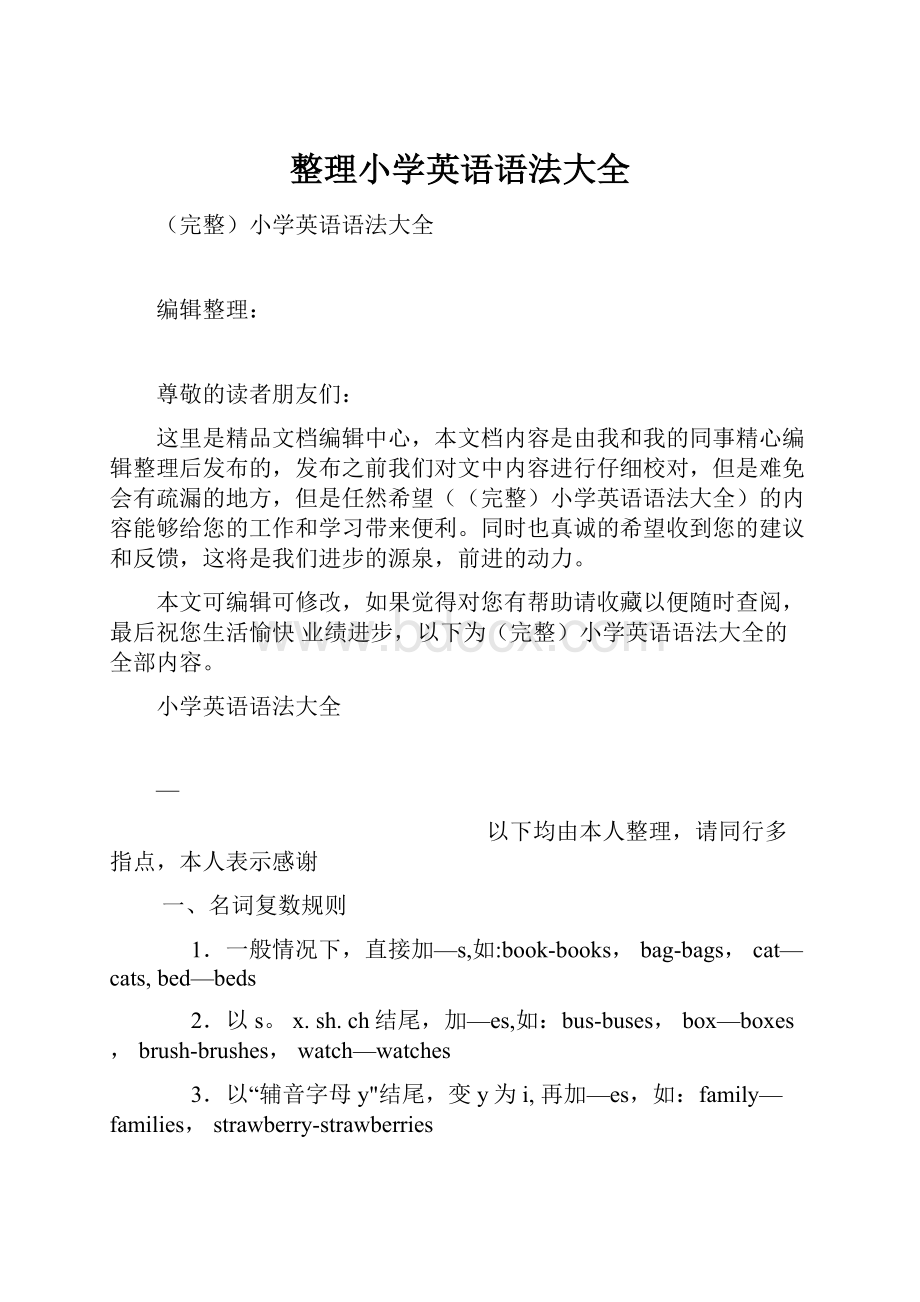整理小学英语语法大全.docx
《整理小学英语语法大全.docx》由会员分享,可在线阅读,更多相关《整理小学英语语法大全.docx(16页珍藏版)》请在冰豆网上搜索。

整理小学英语语法大全
(完整)小学英语语法大全
编辑整理:
尊敬的读者朋友们:
这里是精品文档编辑中心,本文档内容是由我和我的同事精心编辑整理后发布的,发布之前我们对文中内容进行仔细校对,但是难免会有疏漏的地方,但是任然希望((完整)小学英语语法大全)的内容能够给您的工作和学习带来便利。
同时也真诚的希望收到您的建议和反馈,这将是我们进步的源泉,前进的动力。
本文可编辑可修改,如果觉得对您有帮助请收藏以便随时查阅,最后祝您生活愉快业绩进步,以下为(完整)小学英语语法大全的全部内容。
小学英语语法大全
—
以下均由本人整理,请同行多指点,本人表示感谢
一、名词复数规则
1.一般情况下,直接加—s,如:
book-books,bag-bags,cat—cats,bed—beds
2.以s。
x.sh.ch结尾,加—es,如:
bus-buses,box—boxes,brush-brushes,watch—watches
3.以“辅音字母y"结尾,变y为i,再加—es,如:
family—families,strawberry-strawberries
4.以“f或fe"结尾,变f或fe为v,再加—es,如:
knife—knives]
Leaf——leaves
5.不规则名词复数:
man-men,woman-women,policeman-policemen,policewoman—policewomen,
child—children
foot—feet,.tooth—teeth
fish—fish,people—people,Chinese—Chinese,Japanese-Japanese
写出下列各词的复数
I_________him_________this___________her______
watch_______child_______photo________diary______
day________foot________book_______dress________
tooth_______sheep______box_______strawberry_____
peach______sandwich______dish_______bus_______
man______woman_______
二、一般现在时
一般现在时基本用法介绍
【No.1】一般现在时的功能
1。
表示事物或人物的特征、状态。
如:
Theskyisblue。
天空是蓝色的。
2.表示经常性或习惯性的动作。
如:
Igetupatsixeveryday.我天天六点起床.
3.表示客观现实.如:
Theearthgoesaroundthesun。
地球绕着太阳转。
一般现在时的构成
1。
be动词:
主语be(am,is,are)其它.如:
Iamaboy.我是一个男孩。
2。
行为动词:
主语行为动词(其它)。
如:
WestudyEnglish.我们学习英语。
当主语为第三人称单数(he,she,it)时,要在动词后加"—s”或”-es”.如:
MarylikesChinese.玛丽喜欢汉语。
【No。
2】一般现在时的变化
1.be动词的变化。
否定句:
主语benot其它。
如:
Heisnotaworker。
他不是工人。
一般疑问句:
Be主语其它。
如:
-Areyouastudent?
-Yes.Iam。
/No,I'mnot。
非凡疑问句:
疑问词一般疑问句.如:
Whereismybike?
2。
行为动词的变化。
否定句:
主语don't(doesn't)动词原形(其它)。
如:
Idon’tlikebread。
当主语为第三人称单数时,要用doesn't构成否定句。
如:
Hedoesn’toftenplay。
一般疑问句:
Do(Does)主语动词原形其它。
如:
-Doyouoftenplayfootball?
-Yes,Ido./No,Idon’t.
当主语为第三人称单数时,要用does构成一般疑问句。
如:
—Doesshegotoworkbybike?
-Yes,shedoes。
/No,shedoesn't。
动词s的变化规则
1.一般情况下,直接加—s,如:
cook—cooks,milk—milks
2.以s。
x。
sh.ch.o结尾,加—es,如:
guess—guesses,wash—washes,watch-watches,go-goes
3.以“辅音字母y”结尾,变y为i,再加—es,如:
study-studies
一般现在时用法专练:
一、写出下列动词的第三人称单数
drink________go_______stay________make________
look_________have_______pass_______carry____
come________watch______plant_______fly________
study_______brush________do_________teach_______
wash_______
二、用括号内动词的适当形式填空。
1。
Heoften________(have)dinnerathome.
2.DanielandTommy_______(be)inClassOne。
3.We_______(notwatch)TVonMonday。
4.Nick_______(notgo)tothezooonSunday.
5。
______they________(like)theWorldCup?
6.What_______theyoften_______(do)onSaturdays?
7._______yourparents_______(read)newspaperseveryday?
8。
Thegirl_______(teach)usEnglishonSundays.
9。
SheandI________(take)awalktogethereveryevening。
10.There________(be)somewaterinthebottle。
11。
Mike_______(like)cooking。
12。
They_______(have)thesamehobby.
13.Myaunt_______(look)afterherbabycarefully。
14。
Youalways_______(do)yourhomeworkwell。
15.I_______(be)ill.I’mstayinginbed.
16.She_______(go)toschoolfromMondaytoFriday。
17。
LiuTao_______(do)notlikePE。
18。
Thechildoften_______(watch)TVintheevening.
19。
SuHaiandSuYang_______(have)eightlessonsthisterm.
20.-Whatday_______(be)ittoday?
-It'sSaturday
三、现在进行时
1.现在进行时表示现在正在进行或发生的动作,也可表示当前一段时间内的活动或现阶段正在进行的动作.
2.现在进行时的肯定句基本结构为be动词ing.
3.现在进行时的否定句在be后加not。
4.现在进行时的一般疑问句把be动词调到句首.
5.现在进行时的非凡疑问的基本结构为:
疑问词不达意be主语动词ing?
但疑问词当主语时其结构为:
疑问词不达意be动词ing?
动词加ing的变化规则
1.一般情况下,直接加ing,如:
cook—cooking
2.以不发音的e结尾,去e加ing,如:
make-making,taste-tasting
3.假如末尾是一个元音字母和一个辅音字母,双写末尾的辅音字母,再加ing,如:
run—running,stop-stopping
现在进行时专项练习:
一、写出下列动词的现在分词:
play________run__________swim_________make__________
go_________like________write_________ski___________
read________have_________sing________dance_________
put_________see________buy_________love____________
live_______take_________come________get_________
stop_________sit________begin________shop___________
二、用所给的动词的正确形式填空:
1。
Theboy__________________(draw)apicturenow.
2。
Listen.Somegirls_______________(sing)intheclassroom。
3.Mymother_________________(cook)somenicefoodnow.
4.What_____you______(do)now?
5.Look。
They_______________(have)anEnglishlesson。
6.They____________(not,water)theflowersnow.
7。
Look!
thegirls________________(dance)intheclassroom。
8.Whatisourgranddaughterdoing?
She_________(listen)tomusic.
9.It’s5o’clocknow.We_____________(have)suppernow
10.______Helen____________(wash)clothes?
Yes,sheis。
四、将来时理论及练习
一、概念:
表示将要发生的动作或存在的状态及打算、计划或预备做某事.句中一般有以下时间状语:
tomorrow,nextday(week,month,year…),soon,thedayaftertomorrow(后天)等。
二、基本结构:
①begoingtodo;
②willdo.
三、否定句:
在be动词(am,is,are)l后加not或情态动词will后加not成won't.
例如:
I'mgoingtohaveapicnicthisafternoon.→I’mnotgoingtohaveapicnicthisafternoon。
四、同义句:
begoingto=will
Iamgoingtogoswimmingtomorrow(明天)。
=Iwillgoswimmingtomorrow.
练习:
填空。
1.我打算明天和朋友去野炊。
I_____________________haveapicnicwithmyfriends。
I________haveapicnicwithmyfriends。
2.我们将要学习英语
We_____________________learnEnglish.
We________learnEnglish.
五、一般过去时
1.一般过去时表示过去某个时间发生的动作或存在的状态,常和表示过去的时间状语连用。
一般过去时也表示过去经常或反复发生的动作。
2.Be动词在一般过去时中的变化:
⑴am和is在一般过去时中变为was。
(wasnot=wasn’t)
⑵are在一般过去时中变为were。
(werenot=weren’t)
3.句中没有be动词的一般过去时的句子
否定句:
didn’t动词原形,如:
Jimdidn’tgohomeyesterday。
动词过去式变化规则:
1.一般在动词末尾加—ed,如:
work__—worked,cook—cooked
2.结尾是e加d,如:
live____lived
3.末尾只有一个元音字母和一个辅音字母的重读闭音节,应双写末尾的辅音字母,再加—ed,如:
stop-stopped
4.以“辅音字母y”结尾的,变y为i,再加—ed,如:
study-studied
5.不规则动词过去式:
am,is—was,are—were,do-did,see—saw,say—said,give—gave,get-got,go-went,come—came,have-had,eat—ate,take-took,run—ran,sing-sang,put—put,make—made,read-read,write—wrote,draw-drew,drink—drank,swim—swam,sit—sat
过去时练习
写出下列动词的过去式
is\am_________plant________are________
drink_________play_______go________make________
does_________dance________worry________ask_____
taste_________eat__________put______
kick_________pass_______do________
Be动词的过去时练习
(1)
Name____________No。
______Date__________
一、用be动词的适当形式填空
1。
I_______atschooljustnow。
2.He________atthecamplastweek。
3。
We________studentstwoyearsago。
4。
They________onthefarmamomentago.
5。
YangLing________elevenyearsoldlastyear.
6。
There________anappleontheplateyesterday.
7。
There________somemilkinthefridgeonSunday。
8.Themobilephone_______onthesofayesterdayevening。
一、用be动词的适当形式填空
1。
I______anEnglishteachernow.
2。
She_______happyyesterday.
3.They_______gladtoseeeachotherlastmonth.
行为动词的过去时练习
(2)
Name____________No。
______Date__________
一、用be动词的适当形式填空
1.I______(watch)acartoononSaturday。
2.Herfather_______(read)anewspaperlastnight。
3。
We_________tozooyesterday,we_____tothepark。
(go)
4。
______you_______(visit)yourrelativeslastSpringFestival?
5.______he_______(fly)akiteonSunday?
Yes,he______。
6.GaoShan_______(pull)upcarrotslastNationalDayholiday.
7。
I____________(sweep)theflooryesterday,butmymother______.
8。
What______she_______(find)inthegardenlastmorning?
She__________(find)abeautifulbutterfly.
六、人称代词和物主代词
主格宾格形容词性名词性
Imemymine
youyouyouryours
hehimhishis
sheherherhers
itititsits
weusourours
theythemtheirtheirs
习题
一.用所给词的适当形式填空
1.Thatisnot_________kite.Thatkiteisverysmall,but_________isverybig。
(I)
2。
Thedressis_________.Giveitto_________.(she)
3.Isthis_________watch?
(you)No,it’snot_________。
(I)
4._________ismybrother。
_________nameisJack。
Look!
Thosestampsare_________.(he)
二、用am,is,are填空
1。
I______aboy。
______youaboy?
No,I_____not.
2.Thegirl______Jack’ssister。
3。
Thedog_______tallandfat。
4。
Themanwithbigeyes_______ateacher.
5.______yourbrotherintheclassroom?
6.Where_____yourmother?
She______athome.
7。
How_______yourfather?
8。
MikeandLiuTao______atschool。
9.Whosedress______this?
10.Whosesocks______they?
具体用法
1.Hello的用法:
Hello的意思为“您好”,一般可作为熟人,亲朋好友之间的打招呼用语,语气比较随便,例如:
Hello,LiHua!
你好,李华.
Hello,Tom!
你好,汤姆!
Hello也可以用以引起某人注意,常用在打电话时或者在路上碰见熟人时,相当于中文中的“喂”,有时也可用Hi来代替hello,但前者显得更随便。
2.What’syourname?
的用法:
当两人初次见面互相询问姓名时,可用What'syourname?
来提问,回答时,可用Mynameis….来回答,接着反问对方时,可用Andwhat’syourname?
来提问。
例如:
Hi!
What’syourname?
Hi!
MynameisLucy。
Andwhat'syourname?
MynameisWangYing.
你好,你叫什么名字?
你好,我叫露西。
你叫什么